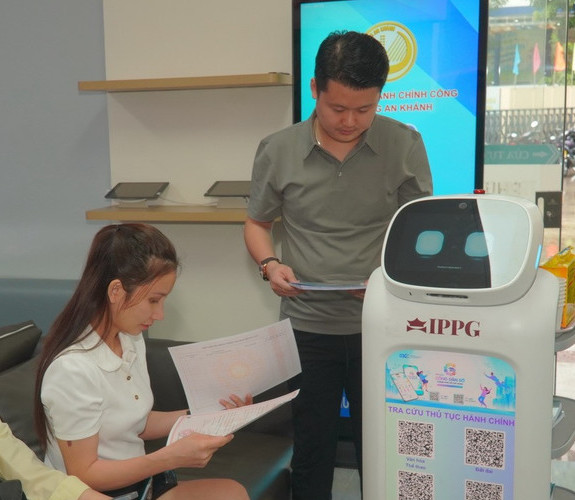 Politics & Law
Politics & Law

 |
| Civil servants of the public administrative service centre in HCM City’s An Phú Đông Ward manage administrative procedures. — Photo sggp.org.vn |
HCM CITY — The HCM City People’s Committee has launched the first phase of its Digital Government Operating System pilot programme — marking a major step in modernising public services and enhancing transparency.
Developed by the Office of the municipal People’s Committee in collaboration with the city’s Digital Transformation Centre, the system connects all departments, districts, wards, and special zones across the city.
Dương Hồng Thắng, chief of the Office of the People’s Committee, said the software could be installed on smartphones and would enable real-time management of documents, tasks, and progress reporting from the central Government and the city’s Party Committee.
“It allows leaders to supervise all departments and districts through a unified digital platform,” he said.
The rollout also includes the mandatory use of Gantt charts — project-scheduling tools that visualise workflows, responsibilities, and timelines — to strengthen accountability and streamline administrative work.
During an inspection of the Rạch Xuyên Tâm Canal renovation project, municipal Party Committee Secretary Trần Lưu Quang asked agencies to apply detailed Gantt charts specifying tasks, responsible officers, and deadlines.
“Without a Gantt chart, it’s impossible to see who’s working, who’s delaying, and where accountability lies,” he said.
At a recent meeting of the city’s Steering Committee on implementing Resolution 57-NQ/TW on digital transformation, Quang said visual tools like Gantt charts were crucial for enhancing leadership efficiency and transparency.
Võ Thị Trung Trinh, director of the city’s Digital Transformation Centre, said the new platform integrated multiple existing systems — including administrative procedure handling, document management, and the 1022 citizen feedback hotline.
“It will generate daily analytical reports to help leaders monitor operations and key socio-economic indicators such as public investment, budgets, and administrative reform, supported by artificial intelligence,” she said.
Through this integration, the city is moving closer to a fully digital government.
It has already connected with 11 national databases, including the National Public Service Portal, the national payment platform, and the national population database.
In 2024, the city prioritised institutional reform and the deployment of seven core technology platforms, such as social media monitoring, enhanced complaint management, and a digital monitoring mechanism for public IT investment.
Experts say integrating Gantt charts and AI-enabled analytics marks a major shift toward quantitative, evidence-based governance.
Nguyễn Trần Nhự Khê, head of the Law Department at the HCM City Cadre Academy, said Gantt charts made evaluations of individuals and teams more transparent and measurable, though they might require refinement for complex projects.
Under the pilot phase, the city expects to fully digitise operations in the coming years to achieve a transparent, efficient, and citizen-centred government.
The software already assigns tasks automatically, issues reminders, and tracks key performance indicators for units and individuals.
Future versions will expand to include management of socio-economic, cultural, defence, and environmental indicators.
 |
| An AI-powered robot at An Phú Ward in HCM City provides residents with administrative forms and information on public procedures for easy access. — VNA/VNS Photo |
The city is also seeking international partnerships to support digital governance.
Collaborations with Australia and Singapore are underway for training, technology transfer, and institutional reform.
The city has launched AI training programmes for civil servants to strengthen human capital and support its smart city vision.
However, experts caution that digital infrastructure alone is insufficient. Deeper coordination among departments, sustainable financial mechanisms, and continued investment in technology and innovation are essential for long-term success.
The city has already developed shared data centres and urban command systems but must continue refining its architecture and governance models.
An important complement to the new system is VNeID, the national electronic identity platform developed by the Ministry of Public Security.
Launched in 2021, VNeID enables secure storage and verification of digital documents, helping reduce paper-based procedures. Its latest updates include services for foreigners, vehicle registration, and ID card exchange.
In HCM City’s digital transformation, it serves as the foundational identity layer that allows public services to be securely verified and streamlined.
Meanwhile, Việt Nam’s growing digital economy provides a supportive environment.
In 2025, Qualcomm opened an AI research and development centre in the country, aligning with national semiconductor and digital infrastructure strategies.
Google is reportedly considering establishing its first large-scale data centre near HCM City to meet rising demand for cloud and AI services.
These developments highlight the momentum driving HCM City’s digital governance ambitions.
The new operating system and Gantt-chart framework represent bold steps toward transparent, efficient, and accountable administration — though continued refinement, institutional support, and human resource development will be key to ensuring their success. — VNS




